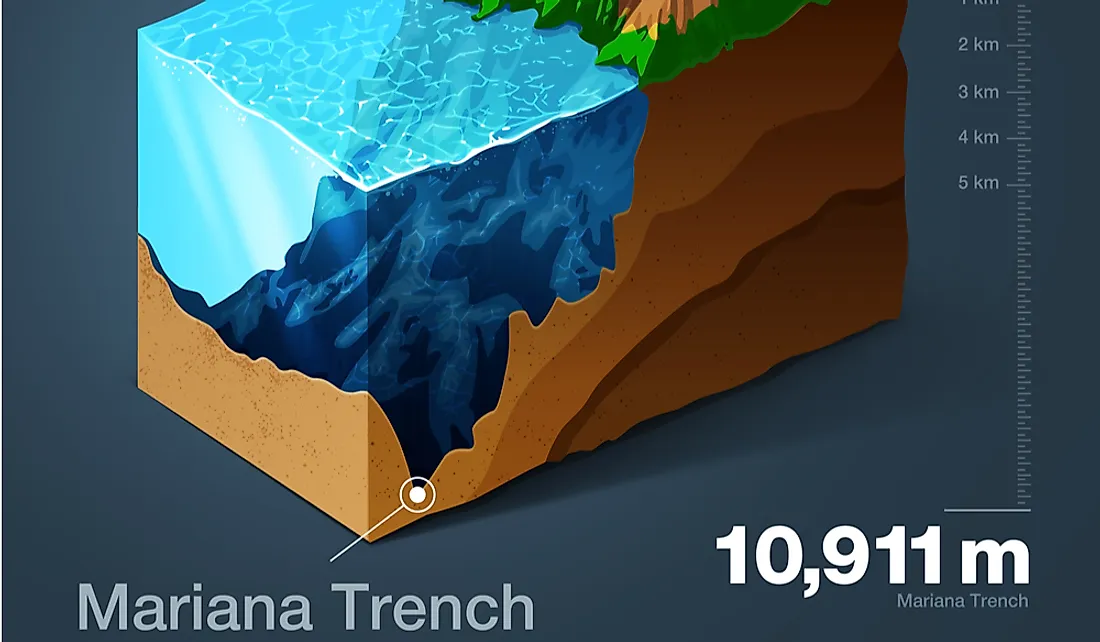The Challenger Deep: The Deepest Place in the World

It’s a known fact that the oceans do not have even terrains and there are some points which are deeper than others. The deepest region of the earth’s ocean is the Challenger Deep. Situated on the floor of the Pacific Ocean, this is a valley on the southern part of the Mariana Trench. Mariana Trench is a 43mi broad crescent-shaped region on the floor of the Pacific Ocean. The Challenger Deep has a depth of approximately 36,070ft (with an error of +/-130ft).
Mariana Trench
The Mariana Trench is situated at the boundary of two converging plates, where two oceanic lithosphere plates collided resulting in one of them descending into the Earth’s mantle. Ocean trenches form some of the most profound valleys on the ocean. An ocean trench is a downward flexure that is formed at the boundary where two lithosphere plates collided.
The Marianas Trench was first measured by a British survey ship known as HMS Challenger in 1875 and the highest depth measured was 26,850ft. In 1951, a second HMS Challenger discovered a deeper point on the Marianas Trench using the echo-sounding technique, which was approximately 35,760ft deeper. In 2009, researchers on RV Kilo Moana doing sonar mapping determined that it was 35,994ft deep with a 72ft error. The most recent measure by the Coastal and Ocean mapping center of the United States in 2010 concluded that the Challenger Deep is 36,070ft deep with a potential error of 130ft.
Exploring the Challenger Deep
Don Walsh and Jacques Piccard were the first individuals to explore this part of the ocean in 1960. Using the Trieste Bathyscaphe, they descended to about 35,814ft. Researchers from Wood-hole oceanographic institute finished the deepest dive in 2009. With a robotic vessel known as Nereus, these researchers attained a depth of approximately 35,767ft. Unlike Kaiko, the Japanese robotic vehicle sent to the Marinas trench in 1998, Nereus was not controlled or powered by a cable which linked it to the mother-ship, and it sent live data to the ship. The latest exploration was by the Haidou, a Chinese vessel, on May 23, 2016, and it attained a depth of about 35,325ft.
Earthquakes at the Marina Trench
The trench formed at the plate boundary between the Pacific and the Philippines lithosphere plates. Although they both move towards the northwest, the velocity of the Pacific was higher than the speed of the Philippines plate. Recurrent earthquakes occur on the boundary since the descent of the Pacific plate into the earth’s mantle is neither uniform nor smooth. As the Pacific plate moves towards the mantle, it is heated by geothermal gradient and friction. Minerals melt from the rocks, and this produces magma which floats towards the surface. As the magma ascends to the top, volcanic eruptions occur.
Life Forms at the Challenger Deep
The report by the HMS Challenger expedition reported two species of radiolarian when they discovered in the Challenger Deep. The radiolarians (Spumellaria and Nassellaria) were published in 1887 by Ernst Haeckel. The camera on the Kaiko probe recorded a shrimp, scale worm, and sea cucumber. Nereus probe sighted an inch long Polychaete-worm at the bottom of the Challenger Deep. Analysis of the samples collected by Kaiko confirmed the presence of large numbers of organisms.











